Question
Draw molecular diagrams to show the condensation reaction between two amino acids to form a dipeptide.
Outline the roles of the different binding sites for tRNA on ribosomes during translation.
Explain the production of antibodies.
▶️Answer/Explanation
Markscheme
a. each amino acid with a COO–/COOH group at one end AND a NH2/NH3+ at the other
Both needed.
mp a requires the double bond to be shown between the C and O.
b. CH in middle with H or R group attached
c. peptide bond correctly drawn between N and C=0
d. COO–/COOH group at one end of dipeptide AND NH2/NH3+ at other end
Both needed.
e. loss of water
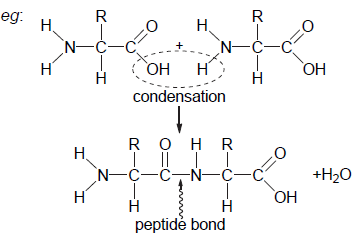
a. A, P and E binding sites are on the large subunit of the ribosome
b. initiation of translation starts with binding of met-tRNA to the start codon
c. large sub-unit binds with «start» tRNA in the P site
d. A binding site holds the tRNA with the next amino acid to be added
e. peptide bond is formed between the amino acids of the A site and the polypeptide at the P site
f. polypeptide is transferred to the tRNA in the A site
g. the tRNA «with polypeptide» in A site then moves to P site
OR
P binding site holds the tRNA attached to the growing polypeptide
h. E binding site «exit» is where the tRNA «from P site without amino acid» leaves the ribosome
Accept annotated diagrams of the sites.
a. each antibody corresponds to a specific antigen
b. antibodies are necessary for immunity/resistance to «infectious» disease
c. macrophage/phagocyte ingests/engulfs pathogen
d. macrophage/phagocyte digests pathogen
e. macrophage/phagocyte displays antigen from pathogen
f. antigens of a pathogen correspond to a specific T lymphocytes/cells
OR
T lymphocytes/cells are activated by antigen binding
g. T lymphocytes/cells activate B lymphocytes/cells
h. «B cells» divide by mitosis to form many/clones of plasma cells
i. plasma cells secrete specific antibody
j. some «activated» B lymphocytes/cells act as memory cells
Accept annotated diagrams of the process
Question
The micrograph shows a cell from the root of an onion (Allium cepa) during mitosis.
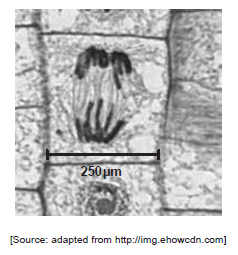
Calculate the magnification of the image.
Deduce the stage of mitosis shown in the micrograph.
The onion (Allium cepa) is an angiospermophyte. The honey bee (Apis mellifera) is an arthropod. State three structural differences between the cells of an onion and a honey bee.
State what is indicated by the presence of polysomes in a cell.
▶️Answer/Explanation
Markscheme
136 (accept answers in the range of 132 to 140)
anaphase
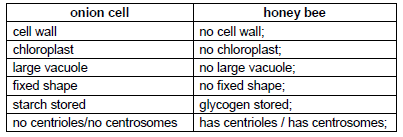
Award [1] for two correct, [2] for three correct answers.
To award the mark both parts of a comparison must be stated explicitly or unambiguously implied.
much protein of one type needed/produced by polysomes;
mRNA is being repeatedly translated;
Question
The diagram below shows the process of transcription.
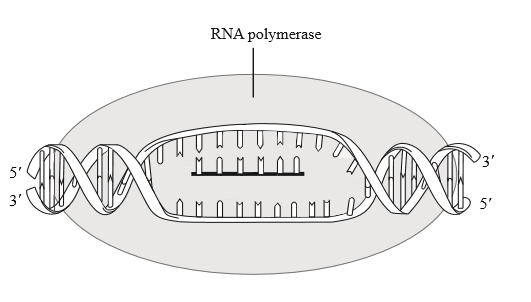
DNA replication involves a number of enzymes including DNA polymerase. Identify one other enzyme involved in DNA replication.
Explain the role of Okazaki fragments in DNA replication.
Label the sense and antisense strands.
Draw an arrow on the diagram to show where the next nucleotide will be added to the growing mRNA strand.
▶️Answer/Explanation
Markscheme
helicase / RNA primase / (DNA) ligase
DNA fragments/sections (formed) on the lagging strand;
because replication must be in the 5′ –3′ direction;
replication starts repeatedly and moves away from replication fork;
both strands clearly labelled
Check carefully whether the correct strand has been labelled if the labels are shown in helical parts of the DNA.
Reject if the sense strand label points to the mRNA.
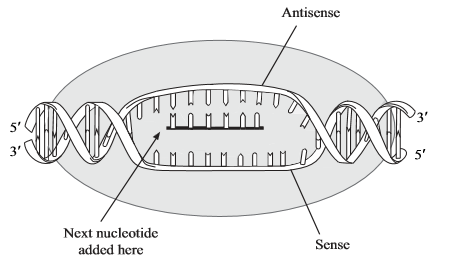
a clearly drawn arrow pointing at the free 3′ end of the mRNA strand or to the first free nucleotide on the antisense strand to the left of the mRNA or to a nucleotide added by the candidate to the left hand end of the mRNA
Question
Genetic engineering allows genes for resistance to pest organisms to be inserted into various crop plants. Bacteria such as Bacillus thuringiensis (Bt) produce proteins that are highly toxic to specific pests.
Stem borers are insects that cause damage to maize crops. In Kenya, a study was carried out to see which types of Bt genes and their protein products would be most efficient against three species of stem borer. The stem borers were allowed to feed on nine types of maize (A–I), modified with Bt genes. The graph below shows the leaf areas damaged by the stem borers after feeding on maize leaves for five days.
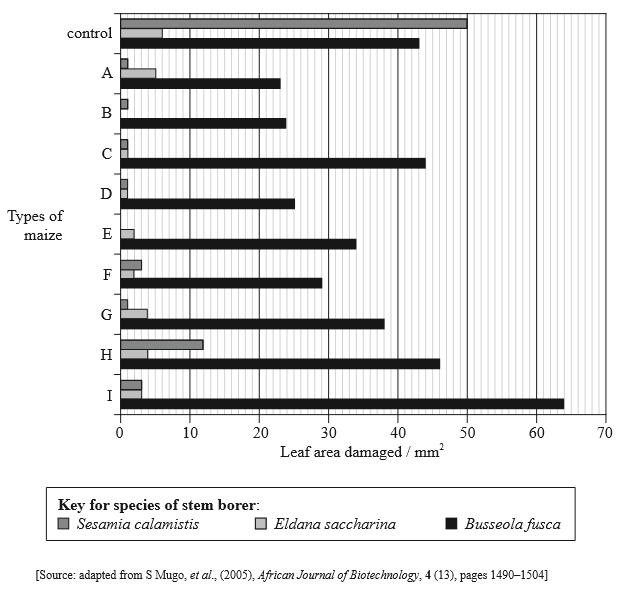
Before the use of genetically modified maize as a food source, risk assessment must be carried out. A 90-day study was carried out in which adult male and female rats were fed either:
• seeds from a Bt maize variety
• seeds from the original non-Bt maize variety
• commercially prepared rat food.
All the diets had similar nutritional qualities.
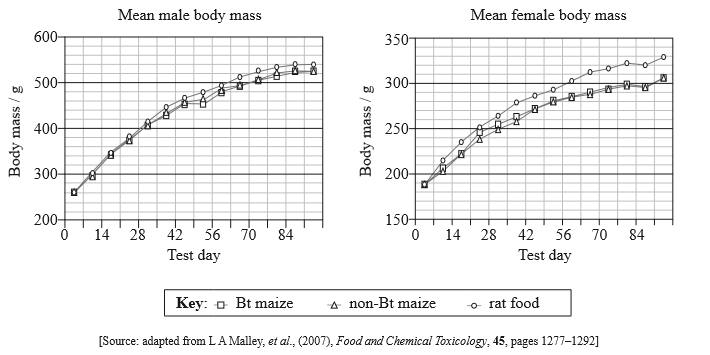
Studies have shown that Bt proteins are released by plant roots and remain in the soil. One study looked at the biomass of microorganisms in soil surrounding the roots of:
• Bt maize
• non-Bt maize
• non-Bt maize with an insecticide (I).
The graph below shows the biomass of microorganisms at two different times in the growth cycle of the plants (Flower and Harvest). Error bars represent standard error of the mean.
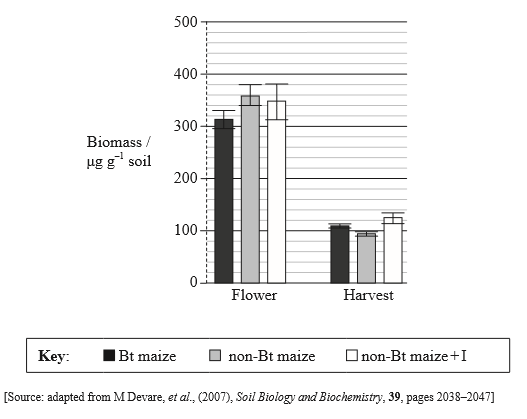
Bt proteins act as toxins to insects, primarily by destroying epithelial cells in the insect’s digestive system. Below is the three-dimensional structure of one such protein.
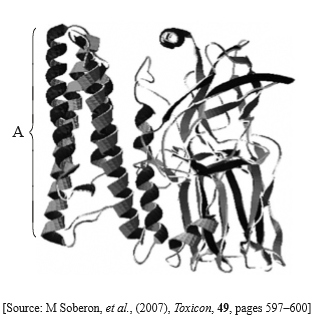
Calculate the percentage difference in leaf area damaged by Sesamia calamistis between the control and maize type H. Show your working.
Discuss which species of stem borer was most successfully controlled by the genetic engineering of the maize plants.
Calculate the change in mean mass of male and of female rats fed on Bt maize from day 14 to 42.
Evaluate the use of Bt maize as a food source on the growth of the rats.
Comment on the use of Bt maize as a food source compared to the other diets tested.
Compare the biomass of microbes in the soils surrounding the roots of Bt maize and non-Bt maize.
The researchers’ original hypothesis stated that microorganisms would be negatively affected by the Bt protein released by the plant roots. Discuss whether the data supports the hypothesis.
State the type of structure shown in the region marked A in the diagram above.
Outline how this structure is held together.
Region A inserts into the membrane. Deduce, with a reason, the nature of the amino acids that would be expected to be found in this region.
▶️Answer/Explanation
Markscheme
50 12 38 (mm ); Accept 12 50 = 38
(38 50) 100 ( )76(%); (ECF)
Sesamia (was most successfully controlled);
in control plants Sesamia caused most damage;
all types of Bt/genetically modified maize/A–I show (significant) decrease in damage by Sesamia;
mark for correct numerical comparison;
Sesamia caused no damage to type E/ in one instance;
Busseola not controlled/affected by Bt/genetically modified maize/caused largest amount of damage in types A–I/increased damage in some varieties;
Eldana controlled by some types of maize / B/C/D but not others / Eldana caused least damage in control and not much difference in many maize types;
males: (440 – 325 =)115g ; (Accept answers in range 105–125 g)
females: (268 – 215 =)53g ; (Accept answers in range 51–57 g)
Units required, no workings required.
(promotes) highest rate of growth at start of study / tapering off later in the study;
Bt maize appears to cause less growth/mass gain than rat food / vice versa;
more pronounced difference in females;
no difference in growth/mass gain between Bt and non-Bt maize;
(Bt) maize may not be as good as the (commercially prepared) rat food;
Bt maize appears to be as good a food source as non-Bt maize;
Bt maize an acceptable/safe food source;
Answers require a judgement about Bt maize as a food source rather than a description.
(for both groups) overall biomasses were higher during flowering than harvest / vice versa
the microbial biomass for the Bt crop was (slightly) lower than for the non-Bt crops at flower time;
the microbial biomass for the Bt crop was (slightly) higher than for the non-Bt crops at harvest time;
data does not support the hypothesis as there is little difference between biomass found in the soil (surrounding) roots (of the Bt and non-Bt) at either time;
data does not support the hypothesis as there is a slightly positive effect at harvest;
data supports hypothesis as there is a slightly negative effect at flowering;
helix / alpha helix
hydrogen bonds;
between the turns of the helix (rather than between R-groups);
bonds between carboxyl and NH groups/C-O—H-N;
non-polar amino acids/R-groups;
(inner part of phospholipid) bilayer is hydrophobic/non-polar;
